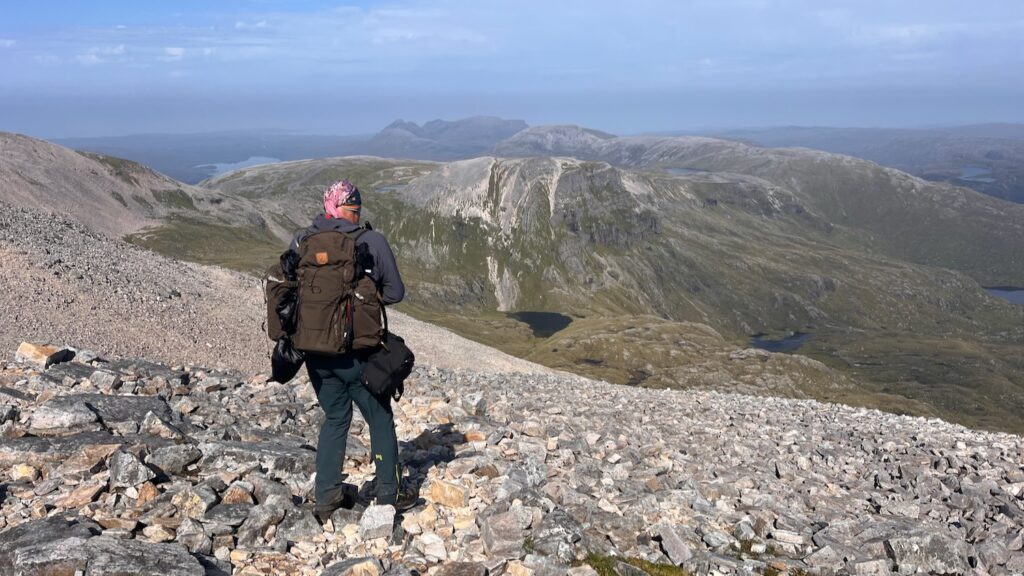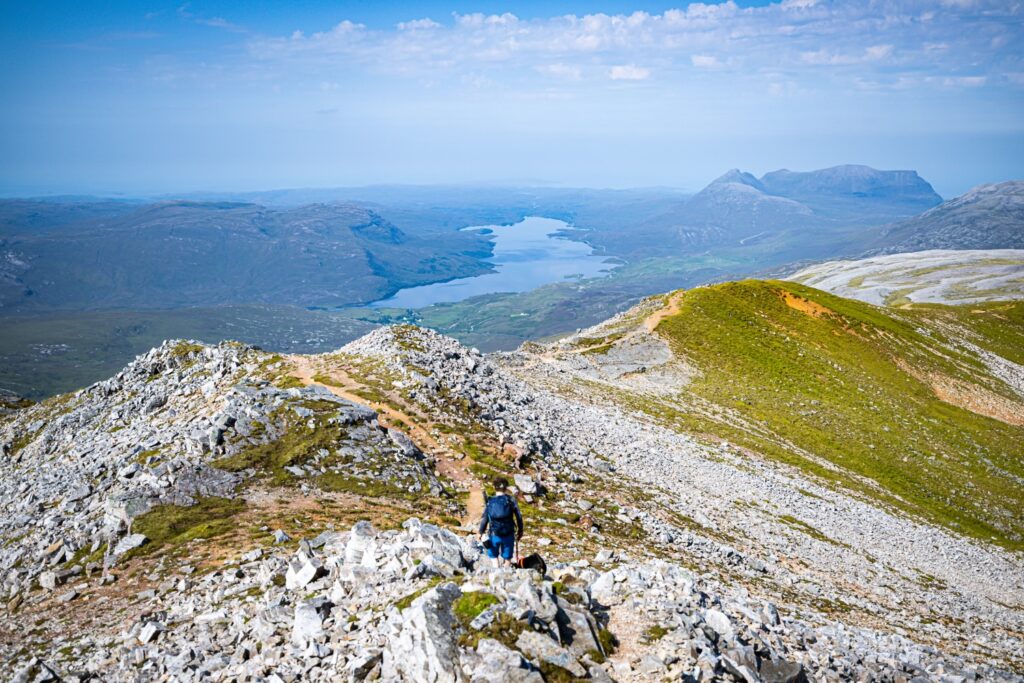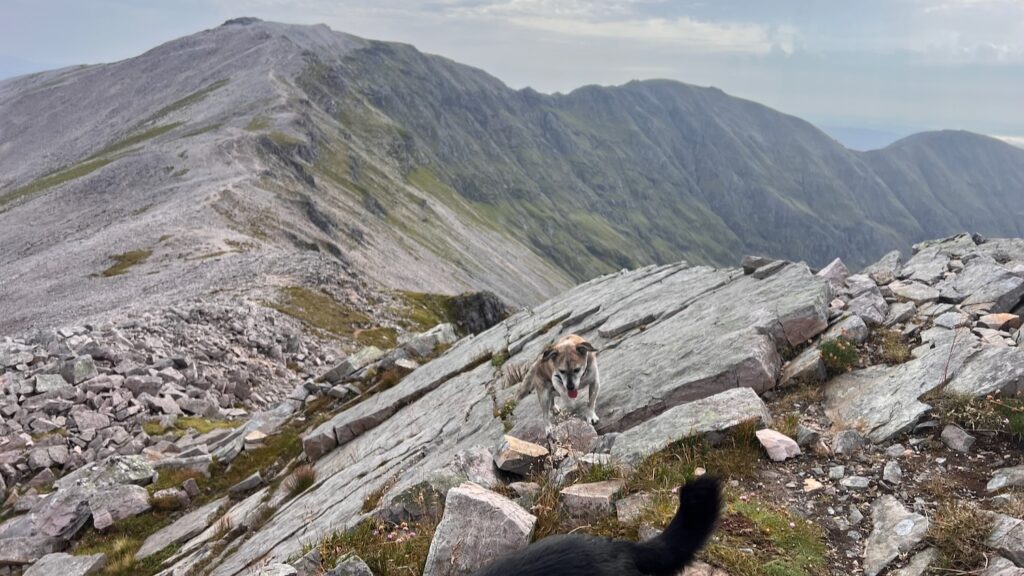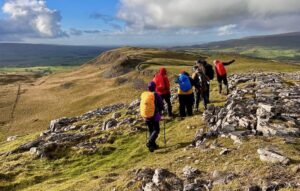
If you’ve ever hiked Ben More Assynt in the Northwest Highlands, you’ll know it’s not just the sweeping views that take your breath away — the geology here is some of the most spectacular (and important) in Scotland. This is a mountain that sits at the heart of a world-famous geological zone where ancient continents collided, rocks folded like pancakes, and the order of time itself got flipped upside-down.

Whether you’re a keen geology buff or just someone who likes a good story in the stones, here’s what to look out for when you set foot on Ben More Assynt.
The Big Picture: Mountains Built in a Slow-Motion Collision
Around 430–400 million years ago, Scotland was caught in the middle of a tectonic pile-up known as the Caledonian Orogeny. Back then, three ancient continents — Laurentia (which Scotland was part of), Baltica, and Avalonia — slowly crashed together, raising a huge mountain range that once rivalled the Himalayas.

The evidence of this event is written in the rocks all around Ben More Assynt, especially in the Moine Thrust Zone — a world-famous geological fault line that cuts right through the area. Here, ancient rocks from deep in the Earth’s crust were pushed sideways over much younger rocks. Imagine stacking your oldest, most precious china on top of IKEA dinner plates, then shoving the whole pile across the table. That’s essentially what happened here — only on a scale of hundreds of kilometres.
The Moine Thrust: Time Turned Upside-Down
The Moine Thrust is one of the most important geological features in the UK. What makes it so special? The rocks on top are hundreds of millions of years older than the rocks underneath — something that shouldn’t happen if the Earth were just laying down sediments in neat, flat layers.
Top tip: Knockan Crag is a cool place to see the Moine Thrust in action! Learn more in our highlights from the NW Highlands Geopark Tour!
When you hike Ben More Assynt, you’re walking right into this zone. Beneath your boots, the pale, tough quartzite is around 500 million years old, formed from ancient beach sands. These quartzites were later squeezed, folded, and shoved over younger rocks during the continental collision.

The Folded Quartzite of Ben Uidhe
From the summit ridge of Ben More Assynt, look south towards Ben Uidhe and you’ll see one of the area’s show-stopping geological sights: folded quartzite.

It looks like giant layers of pale rock that have been bent into graceful ripples — the geological equivalent of crumpled pancakes mid-flip. These folds formed as the immense forces of the Caledonian Orogeny pushed and twisted the rock along the Moine Thrust.
Even if you’re not a geologist, it’s worth pausing to take this in. You’re looking at rock that’s been through hundreds of millions of years of geological drama — from ancient seas to Himalayan-scale mountains to the eroded Highlands we see today.
Na Tuadhan and the Jagged Ridge

Another feature worth noting is Na Tuadhan, the dramatic ridge leading towards Ben More Assynt’s twin summit. Like Ben Uidhe, Na Tuadhan sits in the Moine Thrust Zone, and its jagged outline is the product of hard quartzite resisting erosion. The fractures, tilted layers, and broken cliffs all tell the story of the massive tectonic shove that shaped the Northwest Highlands.
Hiking Tip: How to See the Geology
You don’t need a geology degree to appreciate Ben More Assynt’s rocks — just a bit of observation:
- Look for colour and texture – Pale, blocky quartzite contrasts sharply with the darker schists and gneisses lower down.
- Spot the folds – On Ben Uidhe, the curved layers are easiest to see in the afternoon light when the sun casts shadows.
- Think about the timeline – The rocks you’re standing on are older than dinosaurs, older than life on land, and have travelled from deep inside the Earth to the mountaintop beneath your feet.
Why Ben More Assynt’s Geology Matters
This mountain isn’t just a walker’s challenge — it’s a key site in the history of geology. The Moine Thrust Zone was one of the first places where geologists worked out how huge slabs of crust can move sideways over such long distances, changing our understanding of how mountains form. Without Ben More Assynt and its neighbours, modern geology might have looked very different.
Final Thought
When you’re up on the ridge, wind in your face, with folded quartzite glowing in the sun, it’s worth remembering: these rocks have been through more drama than any human soap opera. The Highlands aren’t just beautiful — they’re the pages of Earth’s oldest history book, written in stone.
Further Reading
- The Moine Thrust: An idea that unravelled mountains – A lively, storytelling-style article tracing the discovery and significance of the Moine Thrust Zone. Great for history buffs and geology novices alike.
- Highlands Controversy of Northwest Scotland – The 19th-century geological debate sparked by the peculiar rock order in the Highlands. Adds colorful context to the thrust fault story.
- Moine Thrust Belt – A concise, informative overview of the Moine Thrust’s structure, timing, and place in global geological history — including its recognition as a UNESCO IUGS Geological Heritage Site.
- Ben More Assynt – A focused entry on the mountain itself, with key geology highlights like the Cambrian quartzite summit, Lewisian gneiss exposures, and the mountain’s nesting within thrust sheets.
- Assynt — The geologists’ Mecca – A rich PDF field guide exploring structural complexities and mapping highlights throughout the Assynt region and Moine Thrust Zone.
- The first mapping of the Moine Thrust Belt, NW Scotland – An academic look at why this area is pivotal to understanding thrust tectonics — especially great for those curious about fault systems and continental collision.
- The thrust structures of southern Assynt, Moine Thrust Zone – A detailed geological study of southern Assynt, including fault sequencing, displacement estimates, and the role of igneous intrusions during thrusting.


 Hilleberg Unna Tent Review
Hilleberg Unna Tent Review
Leave a Reply